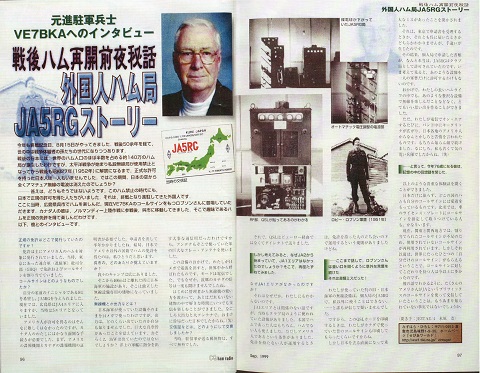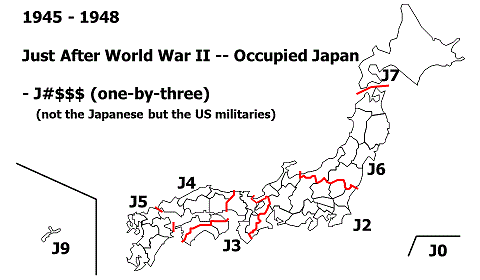
Source: QST Jan., 1947 p.48 (TKS TO JA1BWA)
War was over. American troops stationed in Japan soon started amateur radio using
call signs. But finaly, they were concentrated to J#$$$-types.
See http://motobayashi.net/callbook/occupied-j.html
The call areas basically comes from Japan's pre-war definition. Chosen (Korea) still used Japan's J8-prefix until Feb. 14, 1948 (then they became HL). J9 was shifted from Taiwan and Nan'yo to Okinawa.

During this era, J9AAO in Okinawa made an ultra-DX 16,800 km QSO in 6 meters, with CE1AH of Chile on October 17, 1947 [CQ].
The ITU reduced the prefix block for Japan — and Germany, too — from J to JA-JS, at Atlantic City Conference of 1947 (effective Jan. 1, 1949).
| Before the War | Atlantic City Conference | Later |
|---|---|---|
| D ... Germany | DA-DM ... Germany | DA-DR ... Germany |
| DN-DQ ... Belgian Congo | ||
| DS-DT ... (South) Korea | ||
| DR-DT ... Belorussia, USSR | ||
| DU-DZ ... Philippines | ||
| J ... Japan | JA-JS ... Japan | |
| JT-JV ... Mongolia | ||
| JW-JX ... Norway | ||
| (Not yet assigned) | JY ... Jordan | |
| (Not yet assigned) | JZ ... Netherlands New Guinea (now Indonesia) | |
So the J stations changed their call signs to JA#$$-type 2×2 format on January 1, 1949. GHQ (General Headquarters of the Allied Forces) licensed the amateur stations. Not only Americans but also a Canadian, Robert G. Robson, VE7BKA (ex VE4DO, VE1UC) in Kure was able to get his club's call sign as JA5RG. An applicant was able to get a preferable suffix reflecting his initials as requested [JE3TEA].
In Okinawa, J9, the US allocated the KR6-prefix to there where has been under American military administration, so they chanded their call sings. But the authority only premited US nationals to open amateur stations this time. Not the Japanese nationals.
In the prefix KR6, R stands for Ryukyu, the geoglaphical name of the Islands, and 6 means that here is off-shore islands from the continental W6 area (but very very far...).
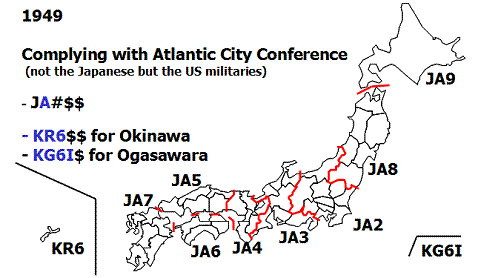
Ogasawara staitions began to use KG6I$ call signs. The following call signs are reported [HG]:
KG61D ... Douglas Reef (= Okino-torishima I.) 1963 by Don Miller, W9WNV KG6IF ... Marcus I.(= Minami-torishima I.), -1965 by N7KA; 1967 by W7CB KG6IG ... Chichijima I. 1965-, by W3KTY KG6IJ ... Iwo I.
JA1EEB/KG6 has operated from Marcus I. by Mr. Tsuboi from Japan Meteorological Agency.
In June 1950, Japan enacted the current Radio Act, in which the word "Amateur Radio" was first appeared in the Japanese law history, and held the first operator examination in that month. The previous law described its station as a "Private Radio Experimental Station," having some restrictions of the output power (10W) and operating hours [JA1BC]. In such a preparation for the reopening of Japan's own amateur radio, in June 1952, American stations quickly—in about half a month—changed their call signs to use KA prefixes, which had been used as KA1 in the Philippines before the war (the A in KA suggests Asia).
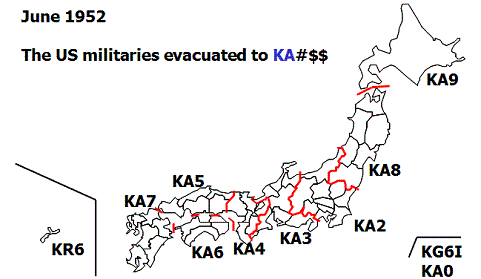
They vacated the JA prefix for the Japanese licensees, while they were remaining as KA AMRS (Auxiliary Military Radio Station) about twenty years after that [JA1AN 23].
By the way, the other series of MARS in Asia existed in American phone band on 40-m. At least AI1, AI2, AI4, AI7, AJ1, AJ2, AJ4 and AJ7 might be in Japan. (The US had gotten the AA-AL block at the Atlantic City Conference of 1947 [QST].) The big differences from KA stations were that (1) they contacted only MARS having call signs of AA-AB, AH-AL and AQ-AR (but some operators sometimes responded to the state-side), and (2) they frequently used coded phrases [JA2RM 1999h2].
"MARS" uses military frequencies for military back up communications and morale use for the US Government.
"AMRS" is a method in place that allows military and US Gov civilians to operate on the Japanese Amateur radio frequencies while in Japan.
Basically, KA2AA-KA9ZZ was used, with some exceptions as follows.
| Call Sign | Year | QTH |
|---|---|---|
| KA2BZF | 1967 | |
| KA2FEC | 1954-1969 | |
| KA2IMB | 1967 | |
| KA2USA | 1954-1956 | |
| KA2USF | 1964-1978 | |
| KA5AKT | 1970-1971 | SS Santa Clara |
| KA0 | KA1 | |||||||||||||||||||||||||||||||||||||||||||||||||
|---|---|---|---|---|---|---|---|---|---|---|---|---|---|---|---|---|---|---|---|---|---|---|---|---|---|---|---|---|---|---|---|---|---|---|---|---|---|---|---|---|---|---|---|---|---|---|---|---|---|---|
| 2×1 |
|
|||||||||||||||||||||||||||||||||||||||||||||||||
| 2×2 |
|
|
||||||||||||||||||||||||||||||||||||||||||||||||
| 2×3 |
|
The FCC adopted the "Group Call Sign System" effective March 24, 1978. After that, Extra Class amateurs were entitled to get "Group A" 2×1 KA1$ call signs,
Advanced got "Group B" 2×2 KA0$$ and KA1$$, and
Novice got "Group D" 2×3 KA1$$$, KA2$$$ and KA5$$$.
In such a situation, under normal conditions, call signs
KA1AA in 1981,
KA1CG in 1981 and
KA1MC in 1978 (Sept. 6)
were supposed to be assigned not in Japan but in the US mainland.
It was KA2AZ, Dec. 30, 1992 - Dec. 30, 1995 as far as the author knows. According to himself, however, his real QRV was until 1993.
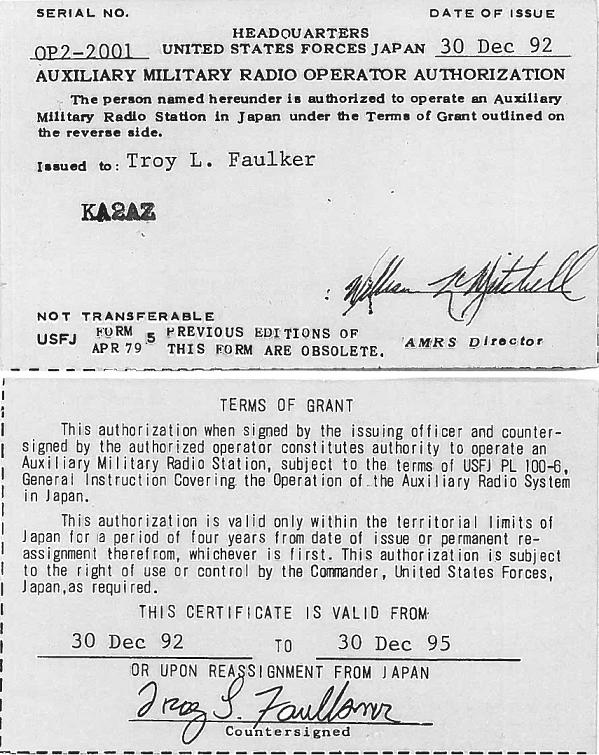
In 1952, Amateur Radio reopened in Japan, by the Japanese.
In June 1951, The authority held the first operator license exam, and in Feb. 1952, began to receive the applications for their station licenses, expecting the Peace Treaty going into effect (Apr. 28, 1952) [ZOKU]. Besides GHQ canceled the prohibition of Amateur Radio on March 11, 1952 [CQ]. and the Radio Administration Committee decided the licensing policy for Amateur Radio at the #76 Meeting on June 19, 1952 [ZOKU], and disclosed it on June 29, 1952 [JA1AN 22].
The new area definition was as the following figure and table:
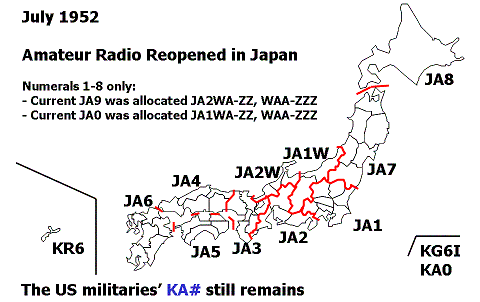
| Administration Office | Call Sign |
|---|---|
| Kanto | JA1AA-JA1VZ JA1AAA-JA1VZZ |
| Shin'etsu | JA1WA-JA1ZZ JA1WAA-JA1ZZZ |
| Tokai | JA2AA-JA2VZ JA2AAA-JA2VZZ |
| Hokuriku | JA2WA-JA2ZZ JA2WAA-JA2ZZZ |
| Kinki | JA3AA-JA3ZZ JA3AAA-JA3ZZZ |
| Chugoku | JA4AA-JA4ZZ JA4AAA-JA4ZZZ |
| Shikoku | JA5AA-JA5ZZ JA5AAA-JA5ZZZ |
| Kyushu | JA6AA-JA6ZZ JA6AAA-JA6ZZZ |
| Tohoku | JA7AA-JA7ZZ JA7AAA-JA7ZZZ |
| Hokkaido | JA8AA-JA8ZZ JA8AAA-JA8ZZZ |
In this way, the Japan's authority finally issued pre-permits — for test transmissions — to thirty applicants on July 29, 1952. July 29 became the "Amateur Radio Day" in Japan later.
| 1 | 2 | 3 | 5 | 6 | 8 | ||||||
|---|---|---|---|---|---|---|---|---|---|---|---|
| JA1AA | Shono (ex J2IB) |
JA2AA | Nakagawa | JA3AA | Shima | JA5AA | Kume | JA6AA | Itabashi | JA8AA | Hama |
| JA1AB | Ichikawa | JA2AB | Nakagawa | JA3AB | Fujimoto | JA6AB | Kumano | JA8AB | Ishida | ||
| JA1AC | Murai (ex J2MI) |
JA2AC | Muramatsu | JA3AC | Yuasa (ex J3FJ) |
JA6AC | Miyahara | ||||
| JA1AD | Saito (ex J2PU) |
JA2AD | Katayama | JA3AD | Fukada (ex J2DJ) |
||||||
| JA1AE | Fukushi (ex J2KM) |
JA3AE | Takei (ex J3ES) |
||||||||
| JA1AF | Nakayama | JA3AF | Sakurai (ex J3FZ) |
||||||||
| JA1AG | Kurokawa | ||||||||||
| JA1AH | Komiya | ||||||||||
| JA1AI | Inaba | ||||||||||
| JA1AJ | Taniguchi | ||||||||||
| JA1AK | Yamanaka | ||||||||||
| JA1AL | Takezawa | ||||||||||
| 1W (now 0) | 2W (now 9) | ||||||||||
| JA1WA | Abe (JA0AA later) |
JA2WA | Emma (JA9AA later) |
||||||||
The following five applicants of them firstly got the real licenses on August 27, 1952: JA1AB, JA1AF, JA1AH, JA1AJ and JA3AA [CQ][JA2RM 2001h2].
Here let's trace two pioneers' call signs. Ken'ichi Kajii became from JAZZ, 3AZ and J3CC to JA1FG; and Koichi Kasahara became from JFMT, 3AA, JXIX, J3DD, J1EZ and J2GR to JA1HAM [JA3HXJ].
From 1952 to 1954, the Shin'etsu district (current Area 0) was a part of the first call area, as well as Hokuriku (current Area 9) was the second. The reason was the authority (1) made resistance to use the numerals 1 and 0, which had not been used before the war, and (2) could not TYPE the character "Ø." Instead of that, JA1WA-ZZ, JA1WAA-ZZZ and JA2WA-ZZ, JA2WAA-ZZZ were allocated to these areas respectively. From these call sign blocks, JA1WA-ZZ and WAA-WAF were actually issued for Shin'etsu and JA2WA-ZS for Hokuriku[OG 8481][OG 8521].
But the authority changed its mind to establish Area 0 and 9 on November 27, 1954 at last. On November 27 [I need to make sure] and on December 15, 1954 for Hokuriku and Shin'etsu respectively, the authority permitted existing JA1WA-ZZ, WAA-WAF and JA2WA-ZS to change to JA0AA-EF and JA9AA-DS respectively.
| District \ Year | Shin'etsu | Hokuriku | ||||
|---|---|---|---|---|---|---|
| Allocated | Issued | Allocated | Issued | |||
| as Provisional License | as License | as Provisional License | as License | |||
| 1952 | ||||||
| JA1WA-ZZ, JA1WAA-ZZZ |
JA1WA-ZZ, JA1WAA-WAF |
JA1WA-ZZ, JA1WAA-WAF |
JA2WA-ZZ, JA2WAA-ZZZ |
JA2WA-ZZ, JA2WAA-WAF |
JA2WA-ZS |
|
| : : |
||||||
| 1954 | ||||||
| JA0 | JA9 | : : |
||||
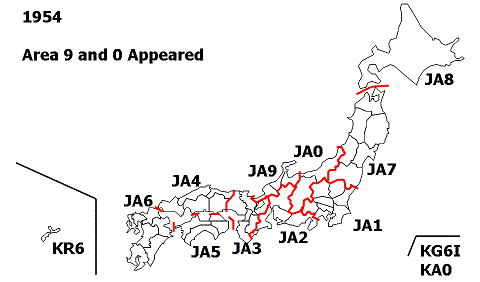
This re-assignment was NOT held all together in a certain day, but it ended up that all JA1WAs and JA2WAs gradually applied for their new JA0 and JA9 call signs.
Of course, new applicants after the change-over, initially got JA0 and JA9 their call signs.
| 1W → 0 | 2W → 9 | ||
|---|---|---|---|
JA1ZS 1954-11-26 JA1ZT 1954-12-02 JA1ZU 1954-12-02 JA1ZV 1954-12-02 JA1ZW 1954-10-29 JA1ZZ 1954-12-14 JA1WAA 1954-12-17 JA1WAB 1954-12-12 JA1WAC 1954-12-17 JA1WAD 1954-12-04 JA1WAF 1955-01-11 |
JADX 1955-02-03 JADY 1955-02-07 JAEI 1955-01-28 JAEJ 1955-02-26 JAEK 1955-03-04 JAEM 1955-03-08 JA0EN 1955-04-13 JAEO 1955-03-08 |
JA2ZJ 1954-12-03 JA2ZM 1954-11-29 JA2ZQ 1954-10-13 JA2ZS 1954-12-01 |
JA9DK 1954-12-28 JA9DL 1955-03-22 JA9DT 1954-12-11 JA9DU 1955-03-18 JA9DV 1954-12-11 JA9DX 1954-12-06 JA9DY 1955-01-25 JA9DZ 1954-12-11 JA9EA 1955-01-29 JA9EB 1955-01-10 JA9EC 1955-03-18 JA9ED 1955-03-29 JA9EE 1955-01-26 JA9EF 1955-03-24 |
whrere,
After this modificaiton, vacated JA1WA-ZZ, WAA-WAF and JA2WA-ZS were recycled in the current first and second call areas as follows:
Consequently current JA1WA-ZZ stations are at least four years "younger" than the other two-letter suffix stations in Kanto (i.e. JA1AA-VZ, licensed 1952-54). In addition, younger than the beginning part of the three-letter suffixes too, because when JA1WA-ZZ was re-issued — the authority gave them to applicans after January 1, 1958[CQ 1958-1] , and exhausted in January and February — the three-letter suffix call signs had issued at least as JA1BZ$ in the first (Kanto) area already.
On the other hand, in the second (Tokai) area, still JA2M$s were being issued when JA9 was carved out. So JA2WA-ZZ were naturally re-issued after JA2VZ, around 1957. [JA2XT]
We had four mergings of municipalities, which crossed the call area borders and occurred slight modifications of them.
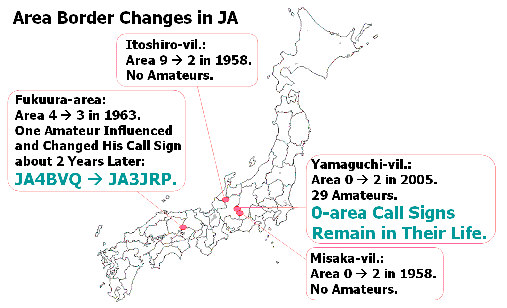
In the case of Fukuura-area, one station had to change his call sign from JA4BVQ to JA3JRP, about two years after the merger. Yamaguchi-village's case, in 2005, is described later.
Ryukyu Government in Okinawa permitted Japanese nationals to establish amateur stations in 1961 at last. The first station by the Japanese in Okinawa was KR8AB since June 22, 1961 [CQ].
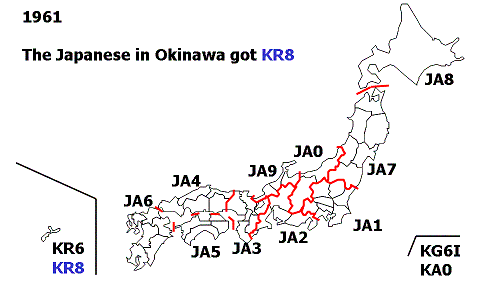
Ogasawara Is. came back to Japan on June 26, 1968. The authority allocated JD1 to here on March 6, 1969 [JA1ADN 1995].

| Administrative District |
Prefix | Islands | DXCC Country/Entity | JCG# | IOTA# | |||
|---|---|---|---|---|---|---|---|---|
| - May 29, 1976 |
May 30, 1976 - Nov. 30, 1980 |
Dec. 1, 1980 - |
||||||
| Ogasawara-vil, Tokyo-pref. |
JD1 | Nishinoshima I. | JD1(/O) | JD1(/O) | JD1(/O) | 10007 | AS-031 | |
| Ogasawara Is. aka Bonin Is. |
Mukojima Is. | |||||||
| Chichijima Is. | ||||||||
| Hahajima Is. | ||||||||
| Kazan Is. aka
Iwo Is. and Volcano Is. |
AS-030 | |||||||
| Okino-torishima I. aka
Douglas Reef and Parece Vera |
7J1 | ex AS-052 (- Feb. 1, 2001) |
||||||
| Minami-Tori-shima I. aka
Marcus I. |
JD1(/M) | OC-073 | ||||||
Ogasawara and Kazan Is. is still a separated country/entity. They were also known as Bonin and Volcano Islands respectively[DXCC]. KG6I, Iwo I. is now belongs JD1(/O).
Minami-Tori-shima I. is another separated country/entity since 1960. It was also known as Marcus I.
Okino-Tori-shima I. has been a separated entity (or a "country" at that time) May 30, 1976 - November 30, 1980 as 7J1.
Okinawa came back from the US to Japan on May 15, 1972. Existing stations KR8AA-ME changed their call signs to JR6AA-ME all together. Newly established stations after that use the JR6QUA-XZZ block followed by all of the JS6 [JA1ADN 1995].
| Administrative District and Prefixes |
Islands and IOTA# | Cities and Guns | ||
|---|---|---|---|---|
| Okinawa-pref.
JR6AA-ME JR6QUA-XZZ JR6YAA-JR6YTQ onwards JS6AAA-JS6QQZ JS6QUA-JS6TGJ onwards Same entity, included in Japan |
Ryukyu Is. | Okinawa Is. AS-017 |
Okinawa I. and Coast |
Most of the cities (Except JCC#4704, 4714);
Kunigami-gun JCG#47001, Parts of Shimaziri-gun JCG#47002 and All of Nakagami-gun JCG#47003 |
| Kerama Is. | Parts of Shimajiri-gun JCG#47002 | |||
| Sakishima Is. | Miyako Is. AS-079 |
Miyakojima-city JCC#4714 and
Miyako-gun JCG#47004 |
||
| Yaeyama Is. AS-024 |
Ishigaki-city JCC#4704 and
Yaeyama-gun JCG#47005 |
|||
| Senkaku Is. |
Ishigaki-city JCC#4704 | |||
| Daito Is. AS-047 |
Parts of Shimaziri-gun JCG#47002 | |||
Thus, the above historical facts made up the CURRENT Japanese call areas.
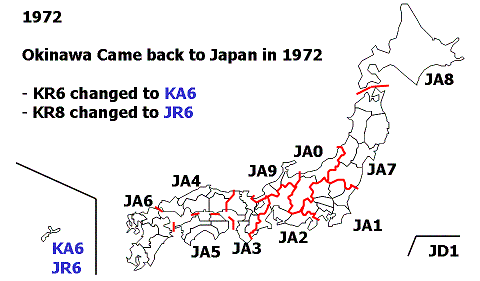
On Feb. 13, 2005, Yamaguchi-mura (or -village), in JCG#09004 Kiso-gun, Nagano-pref. was merged with Nakatsugawa-city (JCC#1906), Gifu-pref. across the call area border from Area 0 to Area 2. But for 29 hams in this area, the authority permitted to maintain their original 0 area call signs.

Each licensee was able to chose to change his/her call sign to a new one of Area 2, or not. In consequence, twenty hams kept their original 0 call signs, while nine hams switched their call signs to new ones as JQ2PIN-PIV.
| JARL Member? | Operating HF? | Call Signs |
| Yes | Yes | JA0DTF, ex-JA0GQP, JA0QWO |
| No | JE0GEX, ex-JH0CBL, JJ0JXI, ex-JR0SRS | |
| No, V,UHF Only |
JE0JED, JF0VKE, ex-JG0EHF, JG0SIA, ex-JG0SIB,
ex-JH0JIA, ex-JI0JFZ, ex-JJ0EYM, ex-JJ0GGQ, ex-JJ0GGR, ex-JJ0GGT, ex-JJ0GIC, JR0CZK |
↓ To |
JG0LOX ↓ JQ2PIT |
JJ0BRW ↓ JQ2PIV |
JJ0GGP ↓ JQ2PIN |
JJ0GGS ↓ JQ2PIO |
JJ0GIF ↓ JQ2PIP |
JJ0JYI ↓ JQ2PIQ |
JJ0KPL ↓ JQ2PIR |
JJ0LIA ↓ JQ2PIU |
JJ0LNK ↓ JQ2PIS |
|---|
— END —
The areas where had been occupied by Japan became independent countries or returned to the original countries.
| Year | Taiwan | Guandong (Kwantung) |
Manchuria | Chosen | Nan'yo (or South Sea) | Sakhalin I. | Kril Is. |
||||||
|---|---|---|---|---|---|---|---|---|---|---|---|---|---|
| Liaodong Pen. | North | South | Mariana | Palau | Caroline | Marshall | South | North | |||||
| 1854 | China | China | Chosen/ Korea |
Spain | Japan | Russia | |||||||
| 1874 | Spain | ||||||||||||
| 1875 | Russia | J7 | |||||||||||
| 1885 | Germany | ||||||||||||
| 1895 Apr. | J9 | Japan | China | ||||||||||
| 1895 May | China | ||||||||||||
| 1899 | Germany | ||||||||||||
| 1905 | J8P | China | J7P | Russia | |||||||||
| 1910 | J8 | ||||||||||||
| 1919 | J9P | ||||||||||||
| 1932 | MX | ||||||||||||
| World War II | |||||||||||||
| 1945 | C3 | XU, C; C9(Manchuria) | J8 | KG6R,S,T KH0 |
J9 KC6 |
J9 KC6 |
J9 KX6 |
UA0F | UA0F | ||||
| 1948 | P5 | HM HL |
|||||||||||
| 1949 | BA-BL, BR-BT, BY-BZ |
||||||||||||
| 1950 | BM-BQ, BU-BX |
||||||||||||
| 1951 | |||||||||||||
| 1953 | |||||||||||||
| 1968 | |||||||||||||
| 1972 | |||||||||||||
| 1991 | V6 | V7 | |||||||||||
| 1994 | T8 | ||||||||||||
Where the Nan'yo (or South Sea) Islands was a mandated territory that the League of Nation gave to Japan between World Wars.
On the other hand, Japan's original areas returned after World War II by a gradual process.
| Year | Okinawa | Amami Is. |
Tokara Is. |
Ogasawara Is. |
The Four Northern Is. | |||
|---|---|---|---|---|---|---|---|---|
| Habomai Is. | Shikotan I. | Kunashiri I. | Etorofu I. | |||||
| Prewar | J5 | J1 J2 |
J7 | |||||
| World War II | ||||||||
| 1945 | J9A KR6, KR8 |
J5 JA7 |
J5 JA7 |
J9 JA0 KG6I |
UA0F | |||
| 1951 | (Japan) | |||||||
| 1953 | JA6 KA7 |
|||||||
| 1968 | JD1 KA0, KA1 |
|||||||
| 1972 | JR6 KA6 |
|||||||
The Japan-Soviet Joint Declaration of 1956 laid down that Habomai Is. and Shikotan I. should be returnable to Japan. But as a matter of fact, Russia is still the administrative authority in the Four Northern Islands.
In addition, South Korea asserted its supremacy on Takeshima Is. in Sea of Japan in 1952, and occupies since 1954. Koren operated HM9A/P (1962), 6M0DX (1998), D98TOK (1998) and D9D (2008) from there.
